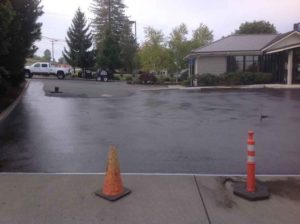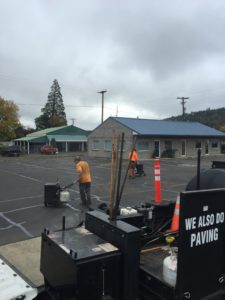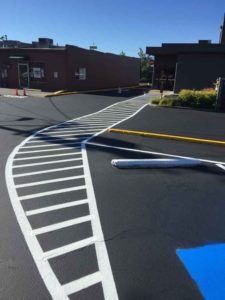Sealcoating Helps Preserve Your Investment
Owned & Operated in Lane County, Oregon. Eugene – Springfield – Cottage Grove
One of the most important aspects of a pavement management plan is sealcoating. A sealcoat consists of either coal asphalt cement or tar pitch mixed with inert fillers, water or emulsifying agents. Applied in thin coats, pavement sealing is used to protect pavement surfaces against gasoline, oil, salt, water, and ultraviolet rays.
Benefits of Sealcoating
Beautification
When applied with a dark black sealant, pavement looks and wears like new. Parking lot seal coating helps to project a positive image of the company, facility, or residential complex.
Slows oxidation and water penetration
Sealcoating fills surface voids, which reduces exposure to oxygen and UV rays and reduces the depth to which oil or gas can penetrate the pavement.
Sealcoating acts as a waterproofing agent, minimizing the rate at which water enters pavement. Without it, water can permeate more freely resulting in freeze/thaw expansion and contraction of the pavement.
Sealcoating resists oil and gas spills
Gasoline dripping from a topped-off fuel tank during hot weather can soften and break down unsealed asphalt pavements. Coal tars used in sealcoat are impervious to gas and oil spills.
Asphalt sealcoating is easier to clean and maintain
Sealcoating fills surface voids while coating the pavement surface. The resulting smooth and even texture makes the surface easier to maintain year-round. For example, snow is easier to remove from a smooth surface, and sweeping is far more effective on a smooth surface.
Sealcoating increases pavement flexibility
Sealcoat brings a dark black color to the pavement. The blacker it is, the more heat a pavement draws from the sun. And, the hotter it gets, the more pliable it becomes, which helps it to withstand traffic without cracking.
Protects asphalt from high power nozzles and pressure washing
Restaurant parking lots often extend to areas near dumpsters, where food-processing machines are pressure washed. Food waste near the dumpsters may also need to be washed away if it can’t be swept away. Sealcoating protects asphalt cement from the high-volume water pressure and detergents used in pressure washing.
Protect your pocket book as well as your product!
Asphalt sealcoating is cost effective!
Preparation and Application
Prior to pavement sealing, any black top flaws or cracks on the pavement must be repaired. Potholes must be removed and replaced, cracks must be cleaned and filled, and oil spots cleaned or prepared.
Hot Rubber Crack Sealing
Crack sealing is used as a first defense against pavement deterioration because it offers several important benefits. Effective crack sealing keeps water from entering and weakening the base or sub-base. It helps preserve the pavement adjacent to the cracks; prevents sand, stone, and dirt from making its way into open cracks causing compressive stresses; and extends pavement life by minimizing crack growth.
Proper attention to cracks will prevent problems from spreading and double the life of the pavement. Pavement repair in the early stages of deterioration will pay big dividends later by delaying costly resurfacing.
Six Types of Asphalt Cracks
1.) Reflective
This type of crack appears primarily in resurfacing projects, although it can also occur in a new pavement. It happens when an existing crack or joint in the underlying pavement structure reflects upward through the surface.
2.) Block
Visually, this type of cracking forms a square pattern, with cracks intersecting each other at nearly right angles. A common cause of this on parking lots is lack of traffic, (steady traffic constantly kneads the pavement and keeps it flexible). Other causes include excessive air voids, low-penetration asphalt, or an overly high plant mix temperature.
3.) Edge
Contrary to previous types, edge cracks appear only parallel to and within 18 inches of the edge of the pavement. Causes include poor base, lack of shoulder support, poor drainage, or frost action.
4.) Joint
Pavement “joints” are created during initial construction when the edges of two pavement mats are placed next to one another. These constructed joints usually have a lower density of asphalt than that of the surrounding pavement. If the mats don’t bond properly (for a variety of reasons), joint cracks appear.
5.) Slippage
Slippage cracks are usually crescent-shaped and caused by heavy traffic that is stopping, turning, or climbing a hill. Resultant stresses cause a bond failure between the upper and lower pavement layers. The open end of the U-shaped crack always points in the direction of the applied force.
6.) Fatigue or Alligator
Over time, a flexible asphalt pavement becomes more rigid and is less able to tolerate vertical deflections. This causes tension in the pavement and results in alligator-type cracking. Such cracking can also occur from structural inadequacy, aging, and oxidation.
It is generally recommended that alligator areas be removed and replaced rather than filled or sealed.
Check out the National Construction & Excavation Photo Gallery Pages below to view a more in depth look at our work!
Asphalt & Paving • Asphalt Sealcoating • Stenciling & Striping • Excavation • Concrete







